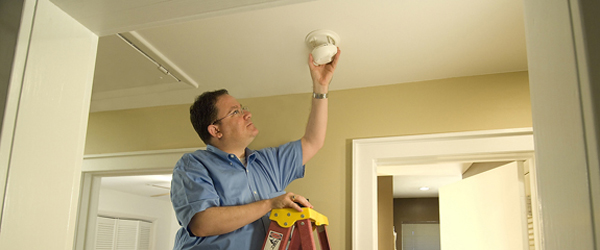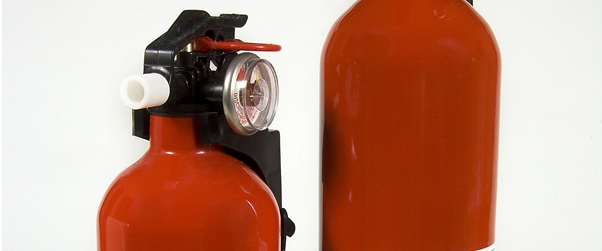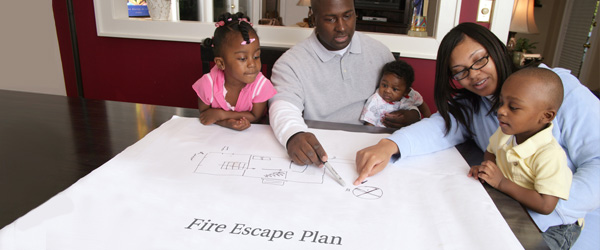Each year more than 2,500 people die and 12,600 are injured in home fires in the United States, with direct property loss due to home fires estimated at $7.3 billion annually. Home fires can be prevented! Grilling on a balcony can be one of the most common causes of apartment fires. Many apartment management companies have written in your rental lease that grilling on a balcony is prohibited. NEVER leave a grill while it is in operation and NEVER leave any type of fire unattended!
Before a Fire
CREATE AND PRACTICE A FIRE ESCAPE PLAN
In the event of a fire, remember that every second counts, so you and your family must always be prepared. Escape plans help you get out of your home quickly.
Twice each year, practice your home fire escape plan. Some tips to consider when preparing this plan include:
- Find two ways to get out of each room.
- If the primary way is blocked by fire or smoke, you will need a second way out. A secondary route might be a window onto a neighboring roof or a collapsible ladder for escape from upper story windows.
- Only purchase collapsible ladders evaluated by a nationally recognized laboratory, such as Underwriters Laboratory (UL).
- Make sure that windows are not stuck, screens can be taken out quickly, and that security bars can be properly opened.
- Practice feeling your way out of the house in the dark or with your eyes closed.
- Windows and doors with security bars must have quick release devices to allow them to be opened immediately in an emergency. Make sure everyone in the family understands and practices how to properly operate and open locked or barred doors and windows.
- Teach children not to hide from firefighters.
Smoke Alarms
- Install both ionization AND photoelectric smoke alarms, OR dual sensor smoke alarms, which contain both ionization and photoelectric smoke sensors
- Test batteries monthly.
- Replace batteries in battery-powered and hard-wired smoke alarms at least once a year (except non-replaceable 10-year lithium batteries)
- Install smoke alarms on every level of your home, including the basement. The U.S. Fire Administration recommends installing smoke alarms both inside and outside of sleeping areas.
- Always follow the manufacturer’s installation instructions when installing smoke alarms.
- Replace the entire smoke alarm unit every 8-10 years or according to manufacturer’s instructions.
- Never disable a smoke alarm while cooking – it can be a deadly mistake. Open a window or door and press the “hush” button, wave a towel at the alarm to clear the air, or move the entire alarm several feet away from the location.
Smoke Alarm Safety People with Access or Functional Need
 Caregivers are encouraged to check the smoke alarms of those who are unable to do it themselves.
Caregivers are encouraged to check the smoke alarms of those who are unable to do it themselves.- Audible alarms for visually impaired people should pause with a small window of silence between each successive cycle so that they can listen to instructions or voices of others.
- Smoke alarms with a vibrating pad or flashing light are available for the hearing impaired. Contact your local fire department for information about obtaining a flashing or vibrating smoke alarm.
- Smoke alarms with a strobe light outside the home to catch the attention of neighbors, and emergency call systems for summoning help, are also available.
More Fire Safety Tips
 Sleep with your door closed.
Sleep with your door closed.- Only those trained in the proper use and maintenance of fire extinguishers should consider using them when appropriate. Contact your local fire department for information on training in your area and what kind to buy for your home.
- Consider installing an automatic fire sprinkler system in your residence.
- Ask your local fire department to inspect your residence for fire safety and prevention.
During a Fire
- Crawl low under any smoke to your exit - heavy smoke and poisonous gases collect first along the ceiling.
- When the smoke alarm sounds, get out fast. You may have only seconds to escape safely.
- If there is smoke blocking your door or first way out, use your second way out.
- Smoke is toxic. If you must escape through smoke, get low and go under the smoke to your way out.
- Before opening a door, feel the doorknob and door. If either is hot, leave the door closed and use your second way out.
- If there is smoke coming around the door, leave the door closed and use your second way out.
- If you open a door, open it slowly. Be ready to shut it quickly if heavy smoke or fire is present.
- If you can’t get to someone needing assistance, leave the home and call 9-1-1 or the fire department. Tell the emergency operator where the person is located.
- If pets are trapped inside your home, tell firefighters right away.
- If you can’t get out, close the door and cover vents and cracks around doors with cloth or tape to keep smoke out. Call 9-1-1 or your fire department. Say where you are and signal for help at the window with a light-colored cloth or a flashlight.
- If your clothes catch fire, stop, drop, and roll – stop immediately, drop to the ground, and cover your face with your hands. Roll over and over or back and forth until the fire is out. If you or someone else cannot stop, drop, and roll, smother the flames with a blanket or towel. Use cool water to treat the burn immediately for 3 to 5 minutes. Cover with a clean, dry cloth. Get medical help right away by calling 9-1-1 or the fire department.
Escaping the Fire
 Make sure windows are not nailed or painted shut. Make sure security gratings on windows have a fire safety opening feature so they can be easily opened from the inside.
Make sure windows are not nailed or painted shut. Make sure security gratings on windows have a fire safety opening feature so they can be easily opened from the inside.- Consider escape ladders if your residence has more than one level, and ensure that burglar bars and other antitheft mechanisms that block outside window entry are easily opened from the inside.
- Teach family members to stay low to the floor (where the air is safer in a fire) when escaping from a fire.
- Clean out storage areas. Do not let trash such as old newspapers and magazines accumulate.
Fire Escape Planning for Older Adults and People Access or Functional Needs
- Live near an exit. You'll be safest on the ground floor if you live in an apartment building. If you live in a multi-story home, arrange to sleep on the ground floor, and near an exit.
- If you use a walker or wheelchair, check all exits to be sure you get through the doorways.
- Make any necessary accommodations, such as providing exit ramps and widening doorways, to facilitate an emergency escape.
- Speak to your family members, building manager, or neighbors about your fire safety plan and practice it with them.
- Contact your local fire department's non-emergency line and explain your special needs. Ask emergency providers to keep your special needs information on file.
- Keep a phone near your bed and be ready to call 911 or your local emergency number if a fire occurs.